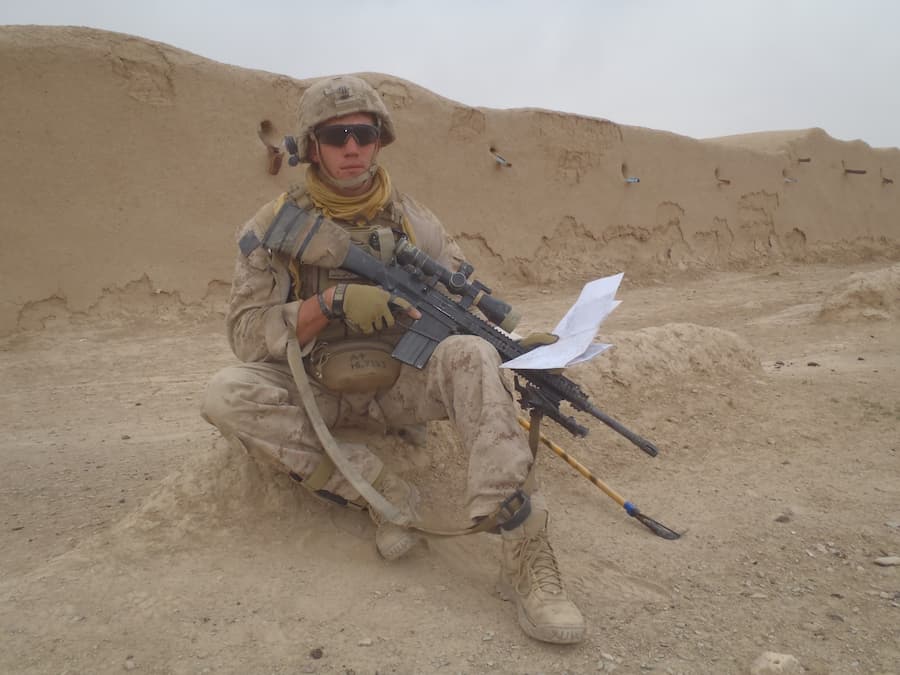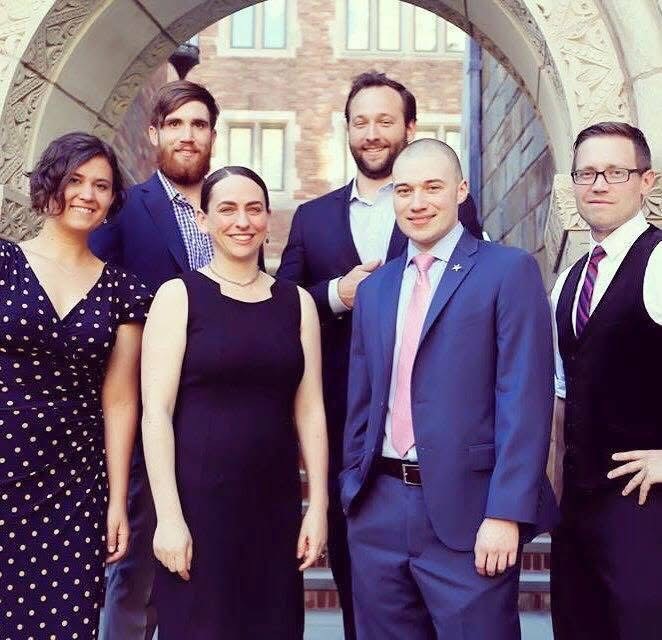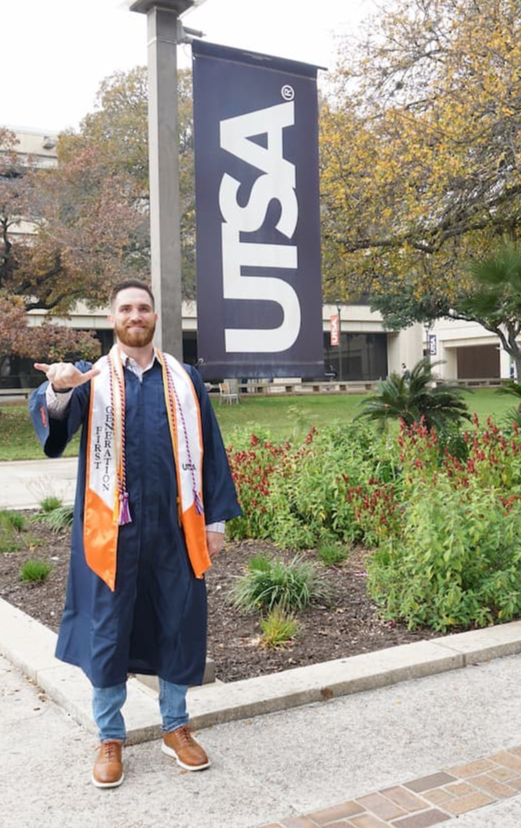Posted on June 9, 2025 by Sean M. Wood

Jeremy during a combat operation in Helmand Province, Afghanistan
UTSA and Klesse College of Engineering and Integrated Design (KCEID) alumnus Jeremy Laster said he has an “attitude of gratitude.” He never imagined being a civil engineer when he was growing up on a dirt road in rural Arkansas.
“Sometimes the journey becomes bigger than the dream,” Laster said outside the offices of Pape-Dawson Engineers, where he’s worked since he was an intern in 2019. “Early on, I never could have dreamed that I would be at this point. Being from ‘dirt-road’ Arkansas, I never would have imagined being where I am today, because I was just trying to make it.”
He’s more than made it, but it’s been a long journey that took him across the country and the planet. Laster served as an elite operator in the Marine Corps and witnessed the horrors of war. He’s a scholar, a husband, and a father of three. Each role has taught Laster that his past didn’t determine his future.
“You have to take what you get, be grateful for it, and run with it,” he said. “That’s what’s always helped me. Find the support you need and don’t create an excuse for yourself.”
Early Expectations
Laster was born in Little Rock but grew up more than half an hour southwest in Glen Rose. He said most people from his town went into the construction business or trundled down the highway to work at the Acme Brick Co. plant.
“College was never pushed on me,” Laster said. “They expected you to play football, which was the highlight, graduate high school, then work construction, at Acme or some other plant, get married, and start a family.”
But Laster left before high school. His parents divorced, and his general contractor father moved to The Woodlands near Houston. Laster went with him.
“It was like a whole different world,” he said, “even though I was just a state over.”
Not all his credits from Arkansas transferred, so he was held back a year. He was enrolled in a program to help him catch up, marking the first time, he said, anyone ever talked to him about the importance of academics.
“I was in The Woodlands for my complete ninth and 10th grade years, but it was already written that I wasn’t interested in college or school at that point,” Laster said. He admitted to being “mischievous,” which led to several parent-teacher conferences. “The teacher would say, ‘Jeremy has lots of potential, if he would just apply himself,’” he said.
California Dreamin’
His dad moved them to San Jose, California, for another construction project after the job in The Woodlands.
“You can imagine going from ‘Dirt Road,’ Arkansas, to The Woodlands to San Jose and Silicon Valley. It was just shellshock after shellshock,” Laster said. “But it opened my eyes and made me thirsty for more of what was out there.”
He was there for his junior and senior high school years, but his father and stepmother moved back to Texas during his senior year. Laster said his father hated California. He loved it, however. He had a “California girlfriend,” and her family offered him a place to stay. Her father gave him a job with his roofing company.
“My dad was a good influence on my life, so when my parents left, I didn’t do the things I needed to do to finish school on time,” Laster said. He became a full-time roofer.
“After a couple of years of roofing, though, you figure out it’s something you don’t want to do,” Laster said. He learned plenty of Spanish and some carpentry skills, but that wasn’t enough to keep him there. He decided to talk to the local Marine Corps recruiter.
Laster said he and his father would watch military movies, such as “The Sniper” with Tom Berenger. The two would also go hunting and fishing in Arkansas. “I grew up knowing how to shoot and hunt, and all that got me interested in serving,” he said.
The Marine Corps helped him earn an adult education certificate, and in June 2008, Laster reported to boot camp at Camp Pendleton.

Transition in Motivation
Laster took the Armed Services Vocational Aptitude Battery (ASVAB), a test that all applicants must take. This standardized test measures abilities and determines suitability for jobs within the service.
Laster’s score gave him more options than some of his peers. Yet he wanted infantry. So, he reported to infantry school after boot camp and said he wanted to be a machine gunner, as he understood it to be the most demanding infantry job.
“There was a transition in my motivation from school to the military, and I learned in the military through a competitive drive to win,” Laster said. “I started scoring in the top percentile in my class in the physical and mental tests. Competition breeds excellence, and I found a drive to compete.”
Laster was in the Marines for five years, was deployed overseas twice, and saw combat in Afghanistan. He was an assistant team leader, and his last job in the Marines was as a scout sniper. Portions of Laster’s description of that job from his resume read like an excerpt from a Tom Clancy novel:
“Conducted clandestine operations as a battalion, regimental combat reconnaissance and surveillance team. Responsible for mission planning, command briefing, and executing missions by delivering long-range precision fire on selected targets in support of combat operations while also collecting and reporting information on enemy activities for intelligence purposes.”
Laster said the Marines gave him an appreciation for engineering when he had to learn Pythagoras’ Theorem to solve for flatline distance when aiming for a target from a high angle. “If you take your shot based on the distance that you’re reading from the top of that hill, because gravity affects the flatline distance, you’ll shoot over their heads all day,” he said. “When I got back to school and did that in my classes, I got excited and decided I wanted to be an aerospace engineer and work for someone like Northrop Grumman.”
Learning to Fail
Laster had witnessed things during his deployments that inspired him to maximize his military benefits for education. He enrolled in a community college in Mission Viejo, California, which had a bridge to engineering program. It’s where he met his wife Leah, whom he called the “smartest person in the program.”
Laster also participated in the pilot Warrior Scholar Program, which essentially teaches veterans how to be successful students. His cohort was at Yale University, and the early focus was on learning to fail.
“Failure is not an option in the military,” he said. “Failure is a bad word. So, if a veteran fails a calculus class, for example, they might decide they’re not cut out for it and just quit. At Yale, we were taught to fail and fail fast. Failing is how you learn.”
Initially, they wrote about government and democracy. They read Alexis de Tocqueville’s “Democracy in America” and wrote about it, learning how to build and defend arguments. He also explored Yale’s rare books collection and held the manuscript of Sir Isaac Newton’s “Principia Mathematica.”

San Antonio, at Last
By 2016, the couple had their first child, Sage. They were going to school and living off Laster’s GI Bill benefits. “We were going into debt every month.”
But they would make annual trips to visit Dr. David Schmidt, team doctor for the Spurs. His son Benjamin, another Marine scout sniper, was Laster’s best friend. He was killed in action in 2011. Benjamin’s mom asked Laster to escort his remains home. “That started our transition to live here,” Laster said.
“One of Dr. Schmidt’s friends, Darren Casey, basically gave us an ultimatum to move out of California,” Laster said. “He said he didn’t want anything. He just wanted us pointed in the right direction. So, I maxed out every credit card we had, loaded everything we had into a moving truck, and drove all night to San Antonio.”
He switched his degree to civil engineering and enrolled at San Antonio College to earn his associate’s degree. As he was graduating, he applied for and received a scholarship from the United Way that covered their child care costs, which allowed Leah to return to school.
“That opened up a lot of doors,” Laster said. “It changed our world. It motivated me to maintain my grades, which in turn allowed Leah to return to school and complete her degree in data science. I cannot express how much it did for us. As soon as I was awarded that scholarship, I was able to apply for internships, and I got one here at Pape-Dawson. I did a full summer before transitioning to UTSA.”
Thanks, UTSA
Laster graduated in 2021 with his bachelor’s degree in civil engineering. He said UTSA was the best place for achieving that.
“If I weren’t a student at UTSA, I wouldn’t have been able to keep my internship at Pape-Dawson going for three straight years while I was a student there, and I wouldn’t be where I am in my career today without the support I received from UTSA,” Laster said. “That includes professors who would go the extra mile to help me out and the great veteran support the school offers.”
“Professors like Sazzad Bin-Shafique, Ph.D., Alberto Arroyo, Ph.D., and Patricio Santamaria were huge for me as I tackled some of my harder engineering classes,” he said. “They always had an open door, and I was always taking advantage of it.”

